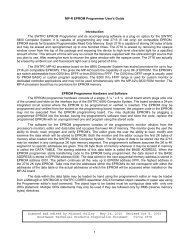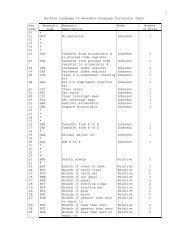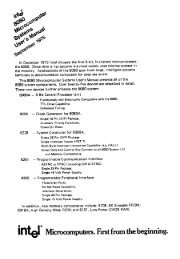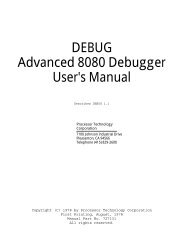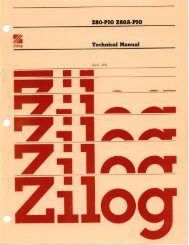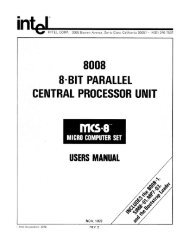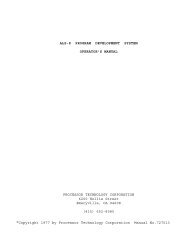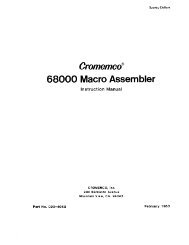The System Manual of SOL-20 - History of Computers
The System Manual of SOL-20 - History of Computers
The System Manual of SOL-20 - History of Computers
You also want an ePaper? Increase the reach of your titles
YUMPU automatically turns print PDFs into web optimized ePapers that Google loves.
V. SUBROUTINES (cont.)<br />
Escape sequence<br />
Function<br />
1B 05 ##<br />
1B 06 ##<br />
1B 07 ##<br />
<strong>The</strong> third byte is output to the VDM at the current<br />
cursor position exactly as is, regardless <strong>of</strong> this<br />
byte's value. No check is made <strong>of</strong> this character<br />
(##). Being a control character, it is only<br />
placed into the VDM memory as-is, and the cursor<br />
is advanced one position.<br />
1B 08 ## <strong>The</strong> display speed is set to the value (##)<br />
specified. <strong>The</strong> speed ranges from 00 (fastest)<br />
to FF (slowest).<br />
1B 09 ## This functions the same as escape sequence 01.<br />
<strong>The</strong> cursor is positioned to character position<br />
## <strong>of</strong> the current display line.<br />
F. Cassette Tape Entry Points to <strong>SOL</strong>OS<br />
<strong>SOL</strong>OS contains subroutines to handle data transfer to and from<br />
two cassette units. Both block-by-block and byte-by-byte access<br />
are available. While performing any tape read, the user can<br />
return to the present calling s<strong>of</strong>tware program by pressing the<br />
MODE (or Control-@) key.<br />
In block transfers, each request results in tape movement and<br />
a transfer <strong>of</strong> an information block to or from a location in<br />
memory. <strong>SOL</strong>OS uses block-by-block access to provide the tape<br />
commands.<br />
In byte transfers, on the other hand, <strong>SOL</strong>OS buffers the data<br />
into 256 byte blocks, doing cassette operations only once per<br />
256 transfers. BASIC uses byte-by-byte access for data files.<br />
Other programs--such as editors, assemblers or special userwritten<br />
programs--can also call the byte-by-byte routines if a<br />
few specific conventions and calling sequences are followed.<br />
File Header<br />
<strong>The</strong> file header for <strong>SOL</strong>OS provides specific attributes to a<br />
file. <strong>The</strong>se attributes consist <strong>of</strong> a five ASCII character name<br />
and a file type.<br />
File name serves two functions:<br />
1. It permits easy human identification <strong>of</strong> the file, and<br />
2. It provides the identification for which <strong>SOL</strong>OS searches<br />
to find the correct file.<br />
File type is used in <strong>SOL</strong>OS to prevent certain operations, such<br />
as automatic XEQ, if the file is not <strong>of</strong> the proper type.<br />
19



